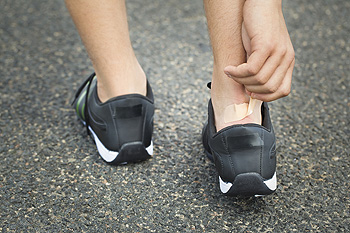 If you have fallen or twisted your foot, you may have sprained your ankle. If you are aware of the importance of treating this condition early, the recovery process may be accelerated. Resting the ankle can be accomplished by not walking on it. Using crutches may be beneficial in eliminating the pressure from the affected joints. Additionally, elevating the foot may reduce any swelling that may be present. A diagnosis may be necessary in determining the severity of the sprain, and if there has been damage done to the tendons and ligaments. For severe sprains, a rehabilitation program may be needed which may be helpful in regaining total mobility of the ankle. If you have sprained your ankle, please consult with a podiatrist as quickly as possible, so the correct treatment can begin.
If you have fallen or twisted your foot, you may have sprained your ankle. If you are aware of the importance of treating this condition early, the recovery process may be accelerated. Resting the ankle can be accomplished by not walking on it. Using crutches may be beneficial in eliminating the pressure from the affected joints. Additionally, elevating the foot may reduce any swelling that may be present. A diagnosis may be necessary in determining the severity of the sprain, and if there has been damage done to the tendons and ligaments. For severe sprains, a rehabilitation program may be needed which may be helpful in regaining total mobility of the ankle. If you have sprained your ankle, please consult with a podiatrist as quickly as possible, so the correct treatment can begin.
Ankle sprains are common but need immediate attention. If you need your feet checked, contact one of our podiatrists from Westside Podiatry Center, LLP. Our doctors can provide the care you need to keep you pain-free and on your feet.
How Does an Ankle Sprain Occur?
Ankle sprains take place when the ligaments in your ankle are torn or stretched beyond their limits. There are multiple ways that the ankle can become injured, including twisting or rolling over onto your ankle, putting undue stress on it, or causing trauma to the ankle itself.
What Are the Symptoms?
- Mild to moderate bruising
- Limited mobility
- Swelling
- Discoloration of the skin (depending on severity)
Preventing a Sprain
- Wearing appropriate shoes for the occasion
- Stretching before exercises and sports
- Knowing your limits
Treatment of a Sprain
Treatment of a sprain depends on the severity. Many times, people are told to rest and remain off their feet completely, while others are given an air cast. If the sprain is very severe, surgery may be required.
If you have suffered an ankle sprain previously, you may want to consider additional support such as a brace and regular exercises to strengthen the ankle.
If you have any questions please feel free to contact one of our offices located in Liverpool, Camillus, Skaneateles, Oswego, and Cicero, NY . We offer the newest diagnostic and treatment technologies for all your foot and ankle needs.



